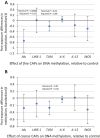DNA hypomethylation, ambient particulate matter, and increased blood pressure: findings from controlled human exposure experiments
- PMID: 23782920
- PMCID: PMC3698788
- DOI: 10.1161/JAHA.113.000212
DNA hypomethylation, ambient particulate matter, and increased blood pressure: findings from controlled human exposure experiments
Erratum in
-
DNA Hypomethylation, Ambient Particulate Matter, and Increased Blood Pressure: Findings From Controlled Human Exposure Experiments.J Am Heart Assoc. 2015 Oct 23;4(10):e001981. doi: 10.1161/JAHA.115.001981. J Am Heart Assoc. 2015. PMID: 26497646 Free PMC article. No abstract available.
Abstract
Background: Short-term exposures to fine (<2.5 μm aerodynamic diameter) ambient particulate-matter (PM) have been related with increased blood pressure (BP) in controlled-human exposure and community-based studies. However, whether coarse (2.5 to 10 μm) PM exposure increases BP is uncertain. Recent observational studies have linked PM exposures with blood DNA hypomethylation, an epigenetic alteration that activates inflammatory and vascular responses. No experimental evidence is available to confirm those observational data and demonstrate the relations between PM, hypomethylation, and BP.
Methods and results: We conducted a cross-over trial of controlled-human exposure to concentrated ambient particles (CAPs). Fifteen healthy adult participants were exposed for 130 minutes to fine CAPs, coarse CAPs, or HEPA-filtered medical air (control) in randomized order with ≥2-week washout. Repetitive-element (Alu, long interspersed nuclear element-1 [LINE-1]) and candidate-gene (TLR4, IL-12, IL-6, iNOS) blood methylation, systolic and diastolic BP were measured pre- and postexposure. After adjustment for multiple comparisons, fine CAPs exposure lowered Alu methylation (β-standardized=-0.74, adjusted-P=0.03); coarse CAPs exposure lowered TLR4 methylation (β-standardized=-0.27, adjusted-P=0.04). Both fine and coarse CAPs determined significantly increased systolic BP (β=2.53 mm Hg, P=0.001; β=1.56 mm Hg, P=0.03, respectively) and nonsignificantly increased diastolic BP (β=0.98 mm Hg, P=0.12; β=0.82 mm Hg, P=0.11, respectively). Decreased Alu and TLR4 methylation was associated with higher postexposure DBP (β-standardized=0.41, P=0.04; and β-standardized=0.84, P=0.02; respectively). Decreased TLR4 methylation was associated with higher postexposure SBP (β-standardized=1.45, P=0.01).
Conclusions: Our findings provide novel evidence of effects of coarse PM on BP and confirm effects of fine PM. Our results provide the first experimental evidence of PM-induced DNA hypomethylation and its correlation to BP.
Keywords: DNA methylation; air pollution; blood pressure; epigenetics; mediation.
Figures



References
-
- WHO Air Quality and Health. 2009Geneva, Switzerland: WHO
-
- Office of Air Quality Planning and Standards Air Now: Action Days. 2011U.S. Environmental Protection Agency
-
- Brook RD, Rajagopalan S, Pope CA, III, Brook JR, Bhatnagar A, Diez‐Roux AV, Holguin F, Hong Y, Luepker RV, Mittleman MA, Peters A, Siscovick D, Smith SC, Jr, Whitsel L, Kaufman JD. Particulate matter air pollution and cardiovascular disease: an update to the scientific statement from the American Heart Association. Circulation. 2010; 121:2331-2378 - PubMed
-
- O'Toole TE, Conklin DJ, Bhatnagar A. Environmental risk factors for heart disease. Rev Environ Health. 2008; 23:167-202 - PubMed
Publication types
MeSH terms
Substances
Grants and funding
LinkOut - more resources
Full Text Sources
Other Literature Sources
Medical
Miscellaneous

